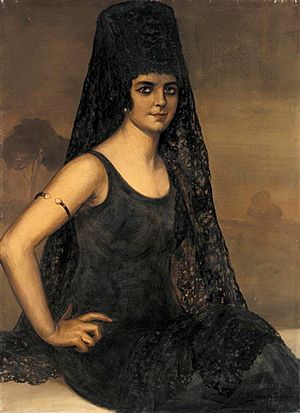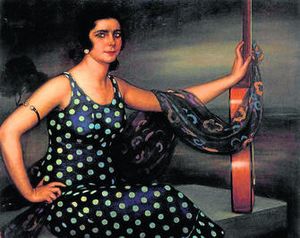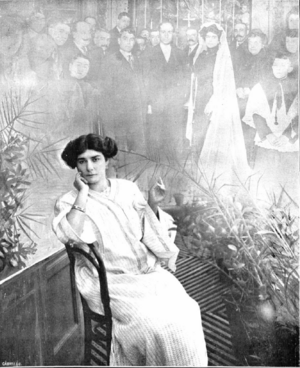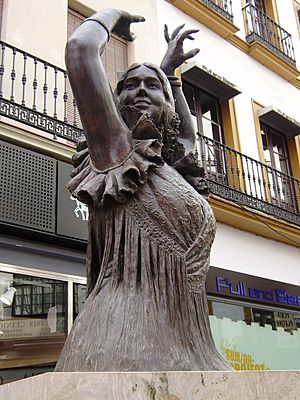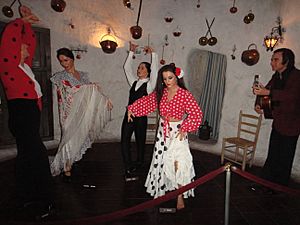Pastora Imperio facts for kids
Quick facts for kids
Pastora Imperio
|
|
|---|---|
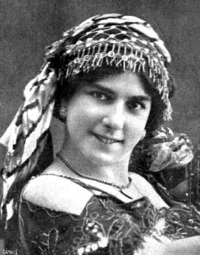
Pastora Imperio, 1914
|
|
| Born |
Pastora Rojas Monje
April 13, 1887 |
| Died | September 14, 1979 (aged 92) |
| Resting place | Cementerio de San Justo |
| Nationality | Spanish |
| Known for | Dancer and Actress |
| Style | Flamenco |
Pastora Imperio was the stage name of Pastora Rojas Monje. She was born on April 13, 1887, in Seville, Spain, and passed away on September 14, 1979, in Madrid. Pastora Imperio was a famous dancer from Seville and one of the most important figures in flamenco history. She was also the great-grandmother of Spanish actress Pastora Vega.
Contents
About Pastora Imperio
Pastora Imperio's mother was Rosario Monje, a dancer from Cádiz known as "La Mejorana." Her father was Víctor Rojas, who made clothes for bullfighters. Her brother, also named Víctor Rojas, was a guitarist.
Pastora started her artistic journey at just ten years old. By the age of twelve, she was known as Pastora Monje. Later, she became Pastora Rojas. Finally, she adopted the name Pastora Imperio when she performed with Margarita la Retoña as the musical duo "Hermanas Imperio." Pastora Imperio quickly became one of the best artists of her time because of her unique style.
Her Popularity and Influence
Pastora Imperio was very popular due to her strong personality. She was admired by many smart and artistic people of her time. She inspired painters, poets, and other artists. For example, Julio Romero de Torres painted her portrait, and Mariano Benlliure created a sculpture inspired by her. Writers like Ramón Díaz Mirete and the Álvarez Quintero brothers wrote about her amazing talent.
She received many awards for her career. These included the Lazo de Dama de la Orden de Isabel la Católica. She also got the first gold medal at the Segunda Semana de Estudios Flamencos in Málaga in 1964. Pastora Imperio was even friends with Queen Victoria Eugenia and had a signed photo from Alfonso XIII, the King of Spain.
Her Artistic Career
Pastora Imperio was famous for performing flamenco styles called garrotín and soleares. Her way of moving her arms and hands, with gentle turns and smooth movements, became a classic example of excellent flamenco braceo (arm movements). She was especially known as a dancer. Pastora Imperio also made the bata de cola (a long, ruffled dress with a train) popular as a typical outfit for flamenco dancing.
Around 1905, she became a star in the zarzuela genre (a Spanish musical play). She performed alongside other famous artists like La Fornarina and Amalia Molina. In 1912, she performed at the Teatro Romea (Madrid) and the Teatro La Latina theaters in Madrid. In 1914, she traveled to Paris and then crossed the Atlantic to perform in countries like Cuba, Argentina, and Mexico.
Her biggest fame came when she was the main dancer in the first show of El amor brujo by Manuel de Falla. This happened on April 15, 1915, at the Teatro Lara in Madrid. The famous writer Jacinto Benavente helped her get this role by connecting her with Manuel de Falla.
On February 14, 1917, she performed for the King and Queen of Spain. This special show was held to support the Red Cross.
After taking a break, Pastora Imperio returned to the stage in 1934. She performed at the Coliseum in Madrid, dancing to the pasodoble (a Spanish dance) called Retrato lírico. A new version of El amor brujo also premiered at the Teatro Español with other great artists. Pastora Imperio also performed other wonderful pieces like Carmen's granddaughter and ¡Viva Madrid!, making them her own.
A music historian named Gilbert Chase wrote in 1941 that Pastora Imperio was the greatest modern Spanish flamenco dancer. He said her way of walking was a gift from God and that she turned it into a new art form.
Between 1942 and 1954, she managed a place called La Capitana. This was a popular spot for artists and was owned by the bullfighter Gitanillo de Triana. In 1957, she performed in a play called Dónde vas Alfonso XII. In 1958, she was part of another show called Te espero en Eslava.
She officially retired in 1959 after performing in Barcelona. After retiring, she opened a flamenco venue (called a tablao) in Madrid with her son-in-law, Rafael Vega de los Reyes. It was named El Duende. In 1964, she opened another tablao in Marbella, Málaga, called Los Monteros.
Films She Appeared In
Pastora Imperio acted in several films during her career:
- La danza fatal (1914)
- La reina de una raza (1917)
- María de la O (1936)
- La marquesona (1940)
- Canelita en rama (1943)
- El amor brujo (1949)
- Duelo en la cañada (1959)
Her Family Life
Pastora Imperio married the famous bullfighter Rafael Gómez Ortega, known as El Gallo (The Rooster), on February 20, 1911. Their marriage lasted less than a year, but they remained legally married until divorce became allowed later.
Pastora had a daughter named Rosario Gómez Rojas, born in 1920. Rafael Gómez recognized Rosario as his daughter and gave her his last name.
Rosario, sometimes called "la Borbona," married bullfighter Rafael Vega de los Reyes, known as "el Gitanillo de Triana," in 1937. Rafael was the younger brother of another bullfighter also named "Gitanillo de Triana," who had passed away earlier. Rosario and Rafael had five children: Curro, Carmen, Pastora, Rafael, and Charo.
Pastora Imperio's famous great-grandchildren include the actress Pastora Vega and the singer Héctor Dona. Héctor Dona even helped write a book about Pastora Imperio's life.
Death and Her Legacy
Pastora Imperio passed away in Madrid on September 14, 1979, when she was 92 years old.
The Duchess of Alba helped pay for a statue in Pastora Imperio's honor. The Monumento a Pastora Imperio shows her dancing with her arms in the air. It was created by the sculptor Luis Álvarez Duarte. The bronze statue was placed on February 14, 2006, in Seville, Spain. Her family was very happy with the location because from there, Pastora could "see every year the procession of the Christ of the Great Power."
The Wax Museum of Barcelona in Barcelona also has a wax statue of her.
Books About Her
A book about Pastora Imperio was written by Madrid journalist María Estévez. It is called Reina del Duende: La vida, los amores y el arte de una mujer apasionada, Pastora Imperio (Queen of Duende: The life, the loves, and the art of a passionate woman, Pastora Imperio).
See also
 In Spanish: Pastora Imperio para niños
In Spanish: Pastora Imperio para niños


